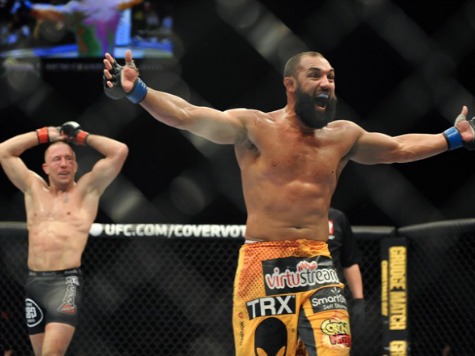Johnny Hendricks dazed UFC welterweight champion George St. Pierre, bloodied him, and even compelled him to contemplate retirement after Saturday night’s fight. He didn’t defeat him–at least in the eyes of two of the judges at MGM Grand Garden Arena in Las Vegas.
The controversial ending to the UFC’s twentieth anniversary card highlights the evolution of the sport. At the first Ultimate Fighting Championship in Denver, Colorado, a disputed outcome like the St. Pierre nod could not have happened. All fights ended by stoppage or submission. These were literally fights to the finish, with no rounds interrupting the action and few rules limiting fighter actions. Judges? They’re for a courtroom, not a cage. The open-weight, tournament-style card meant that the champion had competed three times against very different opponents in one night to win $50,000.
By UFC 167, the purses surely signaled to Dan Severn and Royce Gracie, watching cageside as grayer versions of their past selves, that the sport they pioneered had come a long way. Even before pay-per-view and performance bonuses, headliner GSP earned $400,000–eight times what tournament victor Royce Gracie took home at UFC 1. While just 86,000 sets showed the pay-per view in 1993, Saturday night’s fights may have attracted ten times as many buyers.
Perhaps the greatest difference between the first and most recent UFC card was the mix of martial arts employed. UFC 1 was a coming out party for Brazilian jujitsu. At UFC 167, BJJ didn’t get invited to the party. The main card registered no submissions and few attempts. Whereas the unfamiliarity of the fighting discipline gave Royce Gracie an advantage on the competition at UFC 1, training in the martial art now stands as a prerequisite for any UFC fighter. Its popularity ironically negates its potency. Twenty years into the sport not one of the eight men holding UFC belts count BJJ as the main tool in his arsenal.
The point-fighting unknown to UFC 1 reigned at UFC 167. While massive welterweight Tyron Woodley scored a brutal knockout of Josh Koscheck with a right hook followed by a gratuitous overhand right, the total card featured eight decisions out of twelve fights. Point fighting displayed its perils. Take up-and-comer Rory MacDonald, the skilled but tentative youngster who as of late pecks away at his opponents to earn decision victories. That strategy caught up to him Saturday, as veteran Robbie Lawler’s violent power overwhelmed MacDonald’s calm precision to claim a decision victory. Like his opponent, Lawler was once a wunderkind, debuting in the promotion shortly after his twentieth birthday at UFC 37. The closest thing on the card to a throwback to classic UFC, Lawler demonstrated that experience has its advantages over youth.
And surely UFC owners Dana White and the Fertitta Brothers, in juxtaposing the glitzy, overflow Las Vegas crowd at UFC 167 with the earlier near-empty gathering at Denver’s McNichols Arena for UFC 1–more male in its composition than any Iron Maiden concert–can understand the benefits of age over inexperience.
Daniel J. Flynn is the author of The War on Football: Saving America’s Game (Regnery, 2013).

COMMENTS
Please let us know if you're having issues with commenting.